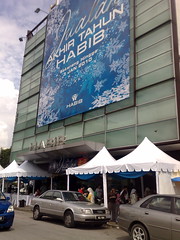HABIB SALE ....

Habib Jewels Sdn. Bhd., one of the Malaysia and, indeed, Southeast Asia's leading jewelry stores, has come a long way since it started out as a small shop on Penang's Pill Street, also known as "Jewelers' Corner" in 1958.
 "From a small family concern, the company evolved to become Habib Corporation Berhad, Malaysia's first-listed jeweler in 1998," reminisces Meer Sadik Habib, the company's Managing Director, who took over the reins of business from his founder father Datuk Haji Habib Mohamed Abdul Latif, in an interview at his headquarters in Kuala Lumpur.
"From a small family concern, the company evolved to become Habib Corporation Berhad, Malaysia's first-listed jeweler in 1998," reminisces Meer Sadik Habib, the company's Managing Director, who took over the reins of business from his founder father Datuk Haji Habib Mohamed Abdul Latif, in an interview at his headquarters in Kuala Lumpur.
The company expanded at what Habib describes as a "breathtaking pace". "This pace of expansion has also enabled us to emerge as a strong player in Malaysia's jewelry industry and as a fully integrated jeweler involved in wholesaling, retailing, manufacturing, marketing and franchising," he says.
Habib Jewels has, meanwhile, established a total of 20 retail outlets throughout the country, including at some strategic points in Kuala Lumpur. Habib maintains that because his company is one of Malaysia's largest buyers of diamonds, it is able to offer customers "competitively priced diamonds with world-renowned certification". But, as experts point out, the jeweler has got a "brand boost" by establishing partnerships in Malaysia with international jewelers such as Queen's Heart Collection and Hearts on Fire (USA).
Most of the jewelry produced in Malaysia is manufactured in Penang. Habib Jewels has also benefited immensely from the fact that Malaysia does not impose any levies on gold, jewelry, stones, etc. This has enabled Malaysia to become the second largest exporter of gold jewelry to the Middle East. "We started out as wholesalers but later switched to retailing. The company, which had a US$80 million turnover in 2008 - exports account for some 20% of its overall turnover - employs some 400 workers and also gives subcontracting work to others.
Apparently, the global economic downturn has also not spared Malaysia's jewelry industry. But, as Habib puts it, "we are confident of riding out the crisis though we are also cautious". The company has a wide range of jewelry products, including jewelry with diamonds and colored stones. "We offer products ranging from low end to high end," he points out.
"We discern that long earrings are a current fashion rage in Malaysia but these are also worn by women in the West," he adds.
Habib, which employs six in-house designers who conceive and design the company's jewelry products, also caters to an exclusive private clientele. "We have different product styles for different markets. When we go to foreign markets, we exhibit products suited to individual tastes of the individual countries," he reveals.
Though Malaysia does produce limited quantities of gold, the metal produced here is not commercially available. Jewellery buyers in Malaysia, like elsewhere in Asia, regard gold-based jewelry as an investment rather than as mere ornament. The quality of Malaysia's gold-based jewelry products is "very good" and has N16 and 22 karat gold content, Habib stresses.
Prices of diamonds have come down in Malaysia. "Prices of large diamond of 1 karat have come down. The prices were artificially hiked and had to, eventually, come down to a reasonable level. But I don't see them falling any further, though suppliers like De Beers are trying to keep prices up by limiting production."
Consumers are, meanwhile, turning to gold as a means of fighting off inflation which eats into their savings. "Our strategy is to try to retain our customers and not lose our customer base. We buy at good rates and pass on the benefits to our customers. Our resilience is our strength which enables us to respond to the changing market situation. In the circumstances, one cannot devise a long-term strategy. We are today working on low margins but high volumes," he says.
But Habib is wary about using the term "current" while describing trends. "Changes are taking place so rapidly that what was current yesterday is no longer of any interest or relevance today. People prefer simple and non-flashy jewelry, and are moving away from showing off or indulging in exhibitionism. Simple designs are making a comeback. As far as high-end products are concerned, consumers go for good quality, certified diamonds while making sure that prices are not very high," he contends.
Although the market is shrinking because of the crisis, Habib believes that there is demand for his products. "I am confident that there will be a gradual recovery by the end of the year. Malaysia has not, yet, felt the impact as much as we had feared. However, we expect the next few months to be challenging though there will also be opportunities. We have not felt the impact in the domestic market but only in our overseas business," he says.



 "From a small family concern, the company evolved to become Habib Corporation Berhad, Malaysia's first-listed jeweler in 1998," reminisces Meer Sadik Habib, the company's Managing Director, who took over the reins of business from his founder father Datuk Haji Habib Mohamed Abdul Latif, in an interview at his headquarters in Kuala Lumpur.
"From a small family concern, the company evolved to become Habib Corporation Berhad, Malaysia's first-listed jeweler in 1998," reminisces Meer Sadik Habib, the company's Managing Director, who took over the reins of business from his founder father Datuk Haji Habib Mohamed Abdul Latif, in an interview at his headquarters in Kuala Lumpur.